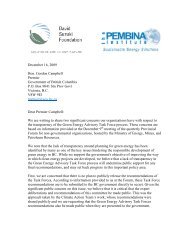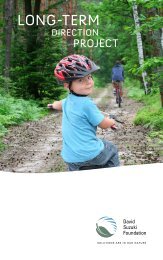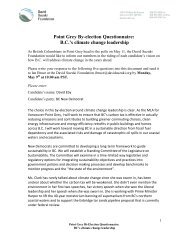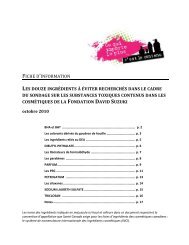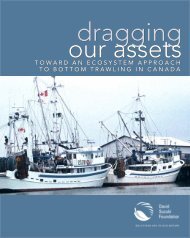An Investigation of Salmon-Habitat Destruction in British Columbia
An Investigation of Salmon-Habitat Destruction in British Columbia
An Investigation of Salmon-Habitat Destruction in British Columbia
Create successful ePaper yourself
Turn your PDF publications into a flip-book with our unique Google optimized e-Paper software.
SUMMARY REPORTHighand DryAN INVESTIGATION OF SALMON-HABITATDESTRUCTION IN BRITISH COLUMBIA
Highand DryA n i n v e s t i g at i o n o f s a l m o n - h a b i tatd e s t r u c t i o n i n b r i t i s h c o l u m b i a
High and Dry: <strong>An</strong> <strong>Investigation</strong> <strong>of</strong> <strong>Salmon</strong>-<strong>Habitat</strong> <strong>Destruction</strong> <strong>in</strong> <strong>British</strong> <strong>Columbia</strong>© 2007 David Suzuki FoundationISBN 1-897375-07-7Canadian Catalogu<strong>in</strong>g <strong>in</strong> Publication Data for this bookis available through the National Library <strong>of</strong> CanadaWritten by John Werr<strong>in</strong>g, M.Sc., R.P. Bio.<strong>Salmon</strong> Conservation Biologist, David Suzuki FoundationJohn has spent the past 17 years research<strong>in</strong>g and <strong>in</strong>vestigat<strong>in</strong>g the causes and extent <strong>of</strong>fish-habitat loss throughout the Pacific region and document<strong>in</strong>g DFO’s failure to meetits habitat-conservation mandate.AcknowledgementsDSF wants to acknowledge the many <strong>in</strong>dividuals who serve as local stream stewards and passionateadvocates for wild salmon who brought many <strong>of</strong> these cases to our attention. We would alsolike to acknowledge the <strong>in</strong>terests, contributions and dedication <strong>of</strong> DFO field staff <strong>in</strong> attempt<strong>in</strong>g torespond to these matters, as we recognize the limitations under which they operate. Special thanksalso go to Jeff Young, Chris Pollen and Heather Deal, who participated <strong>in</strong> the field <strong>in</strong>vestigations,and to Heather Deal, Jay Ritchl<strong>in</strong>, Don Hauka, Bill Wareham and Ian Han<strong>in</strong>gton for contributions<strong>in</strong> edit<strong>in</strong>g this report.This report was made possible by the generous support <strong>of</strong> the Gordon and Betty MooreFoundation and the R. Howard Webster Foundation.The greenhouse gas emissions from the production <strong>of</strong> the paper used <strong>in</strong> this publicationhave been <strong>of</strong>fset through <strong>in</strong>vestments <strong>in</strong> renewable energy projects.David Suzuki Foundation2211 West 4th Avenue, Suite 219Vancouver, BC, Canada V6K 4S2www.davidsuzuki.orgTel 604.732.4228Fax 604.732.0752design and production: Arif<strong>in</strong> Graham, Alaris Designphoto credits: Will Koop (Cover, page 8), John Werr<strong>in</strong>g (pages 4, 5, 6, 7, 9), Poul Rosen (page 10)
C o n t e n t sIntroduction | 1Specific Cases <strong>of</strong> <strong>Habitat</strong> <strong>Destruction</strong> | 3Sir Edmund Bay | 3Stokes Pit/Latimer Pond and Little Campbell River <strong>in</strong> Surrey | 4Sheila Creek, Queen Charlotte Islands | 5Chist Creek | 6<strong>An</strong>weiler Creek | 7Millionaire Creek | 7Private Land Logg<strong>in</strong>g | 8Fraser Gravel | 9House Build<strong>in</strong>g <strong>in</strong> Nanoose Bay Tidal Estuary | 10Results | 12Our Recommendations | 13
T H E A I R W E B R E AT H EIntroductionWild Pacific <strong>Salmon</strong> are an <strong>in</strong>tegral part <strong>of</strong> <strong>British</strong> <strong>Columbia</strong>’snatural environment, culture and economy. So you would th<strong>in</strong>kthat we would do everyth<strong>in</strong>g possible to ensure that they survivewell <strong>in</strong>to the future.However, due to our lack <strong>of</strong> care and attention, we are steadily chipp<strong>in</strong>g awayat the very foundation <strong>of</strong> the wild salmon’s survival: their habitat. Their homes,the native streams <strong>in</strong> which they have reproduced for centuries, are steadily be<strong>in</strong>gdegraded, and <strong>in</strong> the worst cases destroyed, by urban and rural development,<strong>in</strong>dustrial logg<strong>in</strong>g, m<strong>in</strong><strong>in</strong>g and agricultural activity.<strong>Salmon</strong> consistently return to their home streams to spawn. Each <strong>in</strong>dividualstream supports a unique population, or stock, <strong>of</strong> salmon. To date the degradationor loss <strong>of</strong> stream and river habitat <strong>in</strong> <strong>British</strong> <strong>Columbia</strong> has contributed to theext<strong>in</strong>ction <strong>of</strong> more than 142 salmon stocks. <strong>An</strong>other 620 stocks are at high risk <strong>of</strong>ext<strong>in</strong>ction.The federal Department <strong>of</strong> Fisheries and Oceans (DFO) and B.C.’s prov<strong>in</strong>cialenvironment regulatory agencies have the responsibility and authority to protectour salmon and their habitat. In fact, DFO is mandated under the federal FisheriesAct to do so. Yet our <strong>in</strong>tensive field <strong>in</strong>vestigations have shown that the destruction<strong>of</strong> critical salmon habitat cont<strong>in</strong>ues. In this report we highlight how and why thisis this allowed to happen, and we <strong>of</strong>fer suggestions on what needs to be changedto better protect salmon habitat.Federal and prov<strong>in</strong>cial governments have adopted a “results-based” policy approachto environmental regulation. This is a hands-<strong>of</strong>f management approachwhereby project proponents are encouraged to conduct their activities with m<strong>in</strong>imalgovernment oversight. Government is supposed to conduct random audits <strong>of</strong>these activities to ensure that expected results are achieved. The <strong>in</strong>tended result isno net loss <strong>of</strong> fish habitat.
i n t r o d u c t i o nThese policies are part <strong>of</strong> DFO’s new habitat-management regime, called theEnvironmental Process Modernization Plan (EPMP). The plan relies on agreementswith prov<strong>in</strong>cial governments and <strong>in</strong>dustry and on the use <strong>of</strong> “qualified pr<strong>of</strong>essionals”hired by project proponents to undertake environmental reviews where theenvironment, particularly fish habitat, is considered to be at risk.In B.C., the prov<strong>in</strong>cial government has also relaxed its environmental regulatoryand enforcement regime. Both levels <strong>of</strong> government now rely heavily on “qualifiedpr<strong>of</strong>essionals” to determ<strong>in</strong>e whether a project will have an impact on fish habitat,and to propose and conduct mitigation or compensation activities.In the past, federal and prov<strong>in</strong>cial environmental-agency regulatory staff haveconducted this work <strong>in</strong> a transparent and accountable system. Now, however, thenew policies and budget cuts <strong>in</strong> Ottawa and Victoria have reduced the operationalcapacity with<strong>in</strong> DFO and the relevant prov<strong>in</strong>cial m<strong>in</strong>istries to protect fish habitat.The ultimate question now: Is this new approachto habitat management work<strong>in</strong>g?The David Suzuki Foundation <strong>in</strong>vestigated some specific land-development <strong>in</strong>itiativesto f<strong>in</strong>d out. We monitored and documented recent stream and fish-habitatdamage <strong>in</strong> different parts <strong>of</strong> B.C., reported that damage to DFO and monitored theresponse. The results are troubl<strong>in</strong>g. Our observations and experiences suggest thatthe current habitat-protection and management system is not work<strong>in</strong>g.Our <strong>in</strong>vestigation has identified not only problems but also some creative opportunitiesfor solutions. The science has clearly shown us that salmon need cleanwater, healthy spawn<strong>in</strong>g areas and natural vegetation buffers along streams. Thefederal government has the mandate and the legislation to meet these basic needs,and the prov<strong>in</strong>cial government has the management authority to take action onhabitat protection.What is desperately required now is for governments to <strong>in</strong>vest <strong>in</strong> the capacitythat allows their relevant agencies to consistently realize salmon-habitat protection.Political will, a rigorous enforcement and management system, and appropriatef<strong>in</strong>ancial resources are needed to protect habitat and reduce the risks to wild salmonsurvival.The results <strong>of</strong> our <strong>in</strong>vestigations and specific recommendations are presented<strong>in</strong> this summary document. The full <strong>in</strong>vestigative report and detailed case files canbe found at www.davidsuzuki.org.
H I G H A N D D R YThe <strong>Investigation</strong>The David Suzuki Foundation <strong>in</strong>vestigated n<strong>in</strong>e <strong>in</strong>stances <strong>in</strong> which significantfish-habitat damage had been reported. These <strong>in</strong>cluded sites <strong>in</strong>Northern B.C., Haida Gwaii (Queen Charlotte Islands), coastal areas,the Lower Ma<strong>in</strong>land and Vancouver Island. We discovered potentialFisheries Act violations at every site we <strong>in</strong>vestigated.SPECIFIC CASES OF HABITAT DAMAGE1. Sir Edmund BayThe situationThis case <strong>in</strong>volved a f<strong>in</strong>fish aquaculture operation <strong>in</strong> the Broughton Archipelagowith a history <strong>of</strong> not comply<strong>in</strong>g with its operat<strong>in</strong>g permit by expand<strong>in</strong>g well beyondits approved site boundaries and production limits. Rather than charg<strong>in</strong>g thecompany for non-compliance with the rules, the prov<strong>in</strong>cial government approveda new operat<strong>in</strong>g plan and issued a new permit <strong>in</strong> 2002 to br<strong>in</strong>g the company <strong>in</strong>tocompliance with the law. The government did this despite concerns expressed bythe prov<strong>in</strong>cial environment m<strong>in</strong>istry <strong>of</strong> the day that the newly proposed operationwas too big for the site.The <strong>in</strong>vestigationA site visit <strong>in</strong> January 2003 (less than a month after the new plan was approved)revealed that the company was repeat<strong>in</strong>g old habits by operat<strong>in</strong>g well beyond thescope <strong>of</strong> its newly expanded permit. The company was operat<strong>in</strong>g twice the number<strong>of</strong> pens that were approved. Production was more than double the level recommendedby the M<strong>in</strong>istry <strong>of</strong> Environment to protect on-site fish habitat from farmwaste smother<strong>in</strong>g the sea floor.
C A S E F I L E SWe contacted DFO and asked them to <strong>in</strong>vestigate this probable breach <strong>of</strong> theFisheries Act by the company and the Prov<strong>in</strong>ce.The responseA few months after receiv<strong>in</strong>g our compla<strong>in</strong>t, senior Pacific Region DFO staff advisedus that their entire mar<strong>in</strong>e monitor<strong>in</strong>g and enforcement team had been disbanded,their boats pulled out <strong>of</strong> the water and their budget withdrawn, and that their abilityto <strong>in</strong>vestigate compla<strong>in</strong>ts <strong>of</strong> this nature had been compromised as a result. DFOfurther advised us that they would only be conduct<strong>in</strong>g future <strong>in</strong>vestigations and<strong>in</strong>spections <strong>of</strong> salmon farms “if requested to do so”. It has been more than threeyears s<strong>in</strong>ce we brought this matter to the attention <strong>of</strong> the DFO. To date, no punitiveactions have been taken aga<strong>in</strong>st the company or the Prov<strong>in</strong>ce.2. Stokes Pit/Latimer Pond andLittle Campbell River <strong>in</strong> SurreyThe situationThis case <strong>in</strong>volves land-development activities <strong>in</strong> an area <strong>of</strong> Surrey known as StokesPit, a former gravel-m<strong>in</strong><strong>in</strong>g operation <strong>in</strong> the watershed <strong>of</strong> the Little CampbellRiver, an important salmon and trout stream. It was alleged that these activitieswere hav<strong>in</strong>g significant adverse impacts on fish habitats. The land was owned bythe City <strong>of</strong> Surrey.The <strong>in</strong>vestigationA site visit <strong>in</strong> 2005 revealed numerous serious problems: a lake that was an importantlocal fishery was dra<strong>in</strong>ed as a result <strong>of</strong> on-site construction activities; streams andwetlands on the site that had been identified by consultants as Class A fish habitatwere be<strong>in</strong>g bulldozed and filled <strong>in</strong>; stream-side (or “riparian”) vegetation on rema<strong>in</strong><strong>in</strong>gstreams was be<strong>in</strong>g stripped away; <strong>in</strong> two locations fish were blocked fromaccess<strong>in</strong>g their rear<strong>in</strong>g habitat; and on-site construction and surface erosion resulted<strong>in</strong> a thick layer <strong>of</strong> f<strong>in</strong>e sediment be<strong>in</strong>g deposited over much <strong>of</strong> the rema<strong>in</strong><strong>in</strong>g habitat– sediment that clogs fish gills and smothers spawn<strong>in</strong>g habitat. Our <strong>in</strong>vestigatordeterm<strong>in</strong>ed that <strong>in</strong> 15 years <strong>of</strong> do<strong>in</strong>g this k<strong>in</strong>d <strong>of</strong> work he had never witnessed suchsignificant loss <strong>of</strong> fish habitat associated with any one development.We contacted DFO and asked them to <strong>in</strong>vestigate these probable breaches <strong>of</strong> theFisheries Act. In fact, DFO had been <strong>in</strong>formed <strong>of</strong> this problem before. The City <strong>of</strong>Surrey claimed that it had done all that it could to protect fish habitat <strong>in</strong> this area.The responseAfter repeated requests that DFO address this situation, a DFO <strong>of</strong>ficial agreed toallow our <strong>in</strong>vestigator to review the project-approval documents and agreed to a
H I G H A N D D R Yjo<strong>in</strong>t site <strong>in</strong>spection. The document review revealed <strong>in</strong>consistencies <strong>in</strong> site-specific<strong>in</strong>formation concern<strong>in</strong>g fish values, a shock<strong>in</strong>g lack <strong>of</strong> detail on site environmentalvalues and a lack <strong>of</strong> coord<strong>in</strong>ation between agencies review<strong>in</strong>g the proposal.After the site visit, the DFO <strong>of</strong>ficial expressed concern that the proponent mayhave misled him as to the quantity and value <strong>of</strong> fish habitat on the site, and acknowledgedthat the proponent may not have complied with specified conditions<strong>of</strong> project approval or completed requested site-rehabilitation works as specified.Also, even though assessment by a biologist was clearly needed, the person whoreviewed and approved this proposal for DFO was an eng<strong>in</strong>eer who appeared torely on <strong>in</strong>complete documents provided by a “qualified environmental pr<strong>of</strong>essional”reta<strong>in</strong>ed by the proponent.Despite all <strong>of</strong> this, DFO has s<strong>in</strong>ce determ<strong>in</strong>ed that this case does not merit anyaction <strong>of</strong> charges under the Fisheries Act. Unfortunately, this appears to be the way <strong>of</strong>do<strong>in</strong>g bus<strong>in</strong>ess at DFO under its new Environmental Process Modernization Plan.3. Sheila Creek, Queen Charlotte IslandsThe situationThis case <strong>in</strong>volves stream damage associated with a logg<strong>in</strong>g operation on HaidaGwaii. The logg<strong>in</strong>g site is located immediately adjacent to a stream that was identifiedby the logg<strong>in</strong>g company on its logg<strong>in</strong>g plans as a fish-bear<strong>in</strong>g stream.The <strong>in</strong>vestigationA site visit <strong>in</strong> 2005 revealed that timber-harvest<strong>in</strong>g and road-build<strong>in</strong>g activities impactedthree smaller tributary streams that fed directly <strong>in</strong>to a larger stream that hadbeen identified on company logg<strong>in</strong>g plans as a fish-bear<strong>in</strong>g stream. Accord<strong>in</strong>g to therules <strong>of</strong> the day, the three tributary streams should have themselves been classifiedas fish-bear<strong>in</strong>g streams by virtue <strong>of</strong> the fact that they were directly connected to thelarger stream. Two <strong>of</strong> the smaller streams had been completely clear-cut. One was leftwith a partially <strong>in</strong>tact riparian zone, but it had been filled <strong>in</strong> with sediment debrisrelated to road construction and, quite possibly, road failure.These <strong>in</strong>cidents <strong>of</strong> stream mismanagement were reported by telephone to theQueen Charlotte City branch <strong>of</strong> the DFO <strong>in</strong> August 2005.The responseThe first th<strong>in</strong>g that our <strong>in</strong>vestigator learned was that the regular habitat-protection<strong>of</strong>ficer for the Queen Charlottes was on a one-year leave <strong>of</strong> absence. There was atemporary replacement and the <strong>of</strong>fice was <strong>in</strong> transition. In October 2005, we f<strong>in</strong>allyreached an <strong>of</strong>ficial who had conducted a site visit based on our earlier calls. The<strong>of</strong>ficial acknowledged the damage but <strong>in</strong>formed our <strong>in</strong>vestigator that just prior tologg<strong>in</strong>g the company had apparently reclassified the large stream adjacent to the
C a s e f i l e ssite as non-fish-bear<strong>in</strong>g based on its own <strong>in</strong>spection. The DFO <strong>of</strong>ficial admittedhe did not actually see the renewed stream assessment nor did he verify the veracityor accuracy <strong>of</strong> the subsequent stream assessment. So, rather than <strong>in</strong>vestigat<strong>in</strong>gfurther, DFO accepted the new <strong>in</strong>formation provided by the logg<strong>in</strong>g company atface value. We were advised that this approach was consistent with new policy. Asa result, no further action was taken.In this case, the application <strong>of</strong> DFO’s new habitat-management policy may havecompromised fish habitat. Because there was no <strong>in</strong>vestigation conducted, the factscould not be properly determ<strong>in</strong>ed.4. Chist CreekThe situationChist Creek is a valuable fish stream just south <strong>of</strong> Terrace. In its lower reaches it ishome to sockeye, coho and ch<strong>in</strong>ook salmon and ra<strong>in</strong>bow trout. Dolly Varden char,a blue-listed (threatened) species were believed by DFO to occupy the upper streamreaches. Our <strong>in</strong>vestigators were advised <strong>in</strong> 2005 that a significant landslide had occurredon the watershed’s logg<strong>in</strong>g road near Km 15, mak<strong>in</strong>g the road impassable.The <strong>in</strong>vestigationA site visit revealed two massive landslides <strong>of</strong>f the down-slope side <strong>of</strong> the road thatdeposited tonnes <strong>of</strong> rocks, trees and sand directly <strong>in</strong>to the north branch <strong>of</strong> ChistCreek. The cause <strong>of</strong> the slides appeared to be uncontrolled ditch water flow<strong>in</strong>g ontothe road surface at the affected location – perhaps due to a plugged culvert. In addition,a long-banned road-build<strong>in</strong>g technique known as side-cast<strong>in</strong>g (where materialremoved from the land to create the roadway is deposited on the down-slope side<strong>of</strong> the road) was a contribut<strong>in</strong>g cause <strong>of</strong> the slide. In addition, ditches and a newbridge cross<strong>in</strong>g <strong>in</strong>stalled further upstream exposed large amounts <strong>of</strong> m<strong>in</strong>eral soilthat were erod<strong>in</strong>g <strong>of</strong>f the roadway and be<strong>in</strong>g deposited <strong>in</strong>to the stream.The responseWe alerted DFO and <strong>in</strong>formed them that immediate action was needed to assess thecause <strong>of</strong> the road failures. The logg<strong>in</strong>g company had road crews <strong>in</strong> the area work<strong>in</strong>gto repair the road and as a result all evidence <strong>of</strong> the causes <strong>of</strong> the slides wouldbe lost. Local DFO <strong>of</strong>ficials <strong>in</strong>formed our <strong>in</strong>vestigators that they did not have staffavailable to attend the site.More than a month later, we discovered that no one from DFO had yet been toChist Creek, but that the B.C. M<strong>in</strong>istry <strong>of</strong> Forests (MOF) had been advised <strong>of</strong> thesituation and was asked by DFO to conduct an <strong>in</strong>spection. Subsequent conversationswith the MOF made it clear that illegal road-build<strong>in</strong>g practices likely contributed tothe slides, but there was no <strong>in</strong>terest on their part to assess blame. Federal fisheries
H I G H A N D D R Ymust hold the prov<strong>in</strong>ce accountable when they have the responsibility to regulateactivities that harm fish habitat, as happened <strong>in</strong> 2005 when DFO laid charges aga<strong>in</strong>stthe B.C. MOF for logg<strong>in</strong>g <strong>in</strong>fractions.To date, no charges or f<strong>in</strong>es have been imposed <strong>in</strong> these matters. DFO field staffnever went out to <strong>in</strong>vestigate the situation. This appears to be a case where DFOlacked both the capacity to conduct a proper <strong>in</strong>vestigation and the political directionto take action aga<strong>in</strong>st the Prov<strong>in</strong>ce.5. <strong>An</strong>weiler CreekThe situation<strong>An</strong>weiler Creek is a major fish-bear<strong>in</strong>g stream <strong>in</strong> an area north <strong>of</strong> Terrace that hadbeen extensively logged <strong>in</strong> the past, result<strong>in</strong>g <strong>in</strong> a large network <strong>of</strong> <strong>in</strong>tersect<strong>in</strong>glogg<strong>in</strong>g roads. <strong>An</strong> agent <strong>of</strong> the federal Crown encouraged our <strong>in</strong>vestigators to look<strong>in</strong>to logg<strong>in</strong>g-road ma<strong>in</strong>tenance issues and practices <strong>in</strong> the <strong>An</strong>weiler Creek dra<strong>in</strong>agebecause he was concerned that fish habitat <strong>in</strong> the creek was be<strong>in</strong>g harmed andnoth<strong>in</strong>g was be<strong>in</strong>g done to stop it.The <strong>in</strong>vestigationIn 2005 our <strong>in</strong>vestigators visited the site. They found numerous places where thelogg<strong>in</strong>g rods were not be<strong>in</strong>g properly ma<strong>in</strong>ta<strong>in</strong>ed. There was no question thatthe lack <strong>of</strong> road ma<strong>in</strong>tenance was harm<strong>in</strong>g fish habitat <strong>in</strong> <strong>An</strong>weiler Creek, ma<strong>in</strong>lythrough the <strong>in</strong>troduction <strong>of</strong> tonnes <strong>of</strong> silt and logg<strong>in</strong>g debris through landslidesand road erosion caused by plugged culverts.The responseOur <strong>in</strong>vestigators immediately reported the lack <strong>of</strong> road ma<strong>in</strong>tenance and subsequenthabitat damage to both DFO and the B.C. M<strong>in</strong>istry <strong>of</strong> Forests. DFO staff advised usthat they were unable to attend these sites due to other commitments and would passour concerns on to the MOF. MOF subsequently advised our <strong>in</strong>vestigators that anaction plan was be<strong>in</strong>g developed to deal with all the identified road problems. Oneyear later, the promised action plan had not yet been developed. This is clearly a casewhere local DFO field <strong>of</strong>fices are under-staffed and <strong>in</strong>capable <strong>of</strong> respond<strong>in</strong>g to criticalhabitat issues <strong>in</strong> a timely fashion. The MOF also dropped the ball. Cooperationbetween federal and prov<strong>in</strong>cial agencies is not work<strong>in</strong>g as anticipated.6. Millionaire CreekThe situationThis case <strong>in</strong>volved a 43-hectare property development <strong>in</strong> the Millionaire Creek watershed,a fish-bear<strong>in</strong>g stream <strong>in</strong> the District <strong>of</strong> Maple Ridge near Vancouver. Thisdevelopment was be<strong>in</strong>g touted as a green project, with the first guid<strong>in</strong>g pr<strong>in</strong>ciple
c a s e f i l e sbe<strong>in</strong>g “environment first”. Foundation staff visited this site <strong>in</strong> 2006 <strong>in</strong> response tocompla<strong>in</strong>ts from local citizens that heavy surface run<strong>of</strong>f laden with sediment fromland under development was enter<strong>in</strong>g local creeks and harm<strong>in</strong>g fish habitat andthat this had been go<strong>in</strong>g on for some time with the full knowledge <strong>of</strong>, but <strong>in</strong>actionon the part <strong>of</strong>, DFO.The <strong>in</strong>vestigationA site visit on a ra<strong>in</strong>y day proved the concerns to be legitimate. While the land developerhad made some attempts to manage sediment from build<strong>in</strong>g sites, there wasstill a great deal <strong>of</strong> run-<strong>of</strong>f from the stripped-bare sites. In fact, erosion was visiblearound the foundation <strong>of</strong> some <strong>of</strong> the new homes under construction. Sedimentwas be<strong>in</strong>g discharged through dra<strong>in</strong>age pipes <strong>in</strong>to the nearby fish-bear<strong>in</strong>g creek. Alocal resident advised our <strong>in</strong>vestigator that this sort <strong>of</strong> discharge had been occurr<strong>in</strong>gregularly and that local residents had reported this repeatedly to both DFO and localmunicipal-government <strong>of</strong>ficials. Although an environmental monitor was requiredto be on-site dur<strong>in</strong>g construction, no monitor was observed. Our <strong>in</strong>vestigator sawother nearby construction sites with similar dra<strong>in</strong>age problems.The responseWhen our <strong>in</strong>vestigator contacted DFO regard<strong>in</strong>g this problem, he was told that DFOhad sent a generic letter to local developers request<strong>in</strong>g that they develop properstorm-water and siltation management plans for construction sites and that theplans be submitted to DFO for approval. DFO did not answer repeated requests for<strong>in</strong>formation concern<strong>in</strong>g whether these reports were ever submitted and/or whetherthere had been compliance follow-up.Clearly this was a situation where DFO lacked the capacity and/or will to conductfield <strong>in</strong>vestigations <strong>in</strong> response to citizen concerns and relied more on <strong>in</strong>dustry todo the right th<strong>in</strong>g.7. Private Land Logg<strong>in</strong>g, Beaufort Mounta<strong>in</strong>Range, Port AlberniThe situationA logg<strong>in</strong>g company had been logg<strong>in</strong>g extensive portions <strong>of</strong> the west-fac<strong>in</strong>g slopes<strong>of</strong> the Beaufort Mounta<strong>in</strong> Range near Port Alberni. Small streams on the loggedslopes fed <strong>in</strong>to a famous fish<strong>in</strong>g river, the Stamp. Two small communities at thebase <strong>of</strong> the slope also rely on these streams for dr<strong>in</strong>k<strong>in</strong>g water. After an extendedperiod <strong>of</strong> heavy ra<strong>in</strong>, the logg<strong>in</strong>g road failed <strong>in</strong> several locations, primarily due to<strong>in</strong>adequately sized and placed culverts.
H I G H A N D D R YThe <strong>in</strong>vestigationOur <strong>in</strong>vestigator visited the site <strong>in</strong> January 2006 and aga<strong>in</strong> <strong>in</strong> April 2007. It wasclear from our <strong>in</strong>spections that culvert failure had caused several road washoutsand subsequent damage to at least two fish streams below. The <strong>in</strong>vestigator determ<strong>in</strong>edthat the logg<strong>in</strong>g company had not <strong>in</strong>stalled a sufficient number <strong>of</strong> culverts,or properly sized culverts, to handle the run<strong>of</strong>f.The responseAttempts to get DFO to pursue this case resulted <strong>in</strong> no action by the agency at all.Instead, <strong>in</strong>vestigation <strong>in</strong>to the matter was left up to a prov<strong>in</strong>cial agency known as thePrivate Managed Forest Land Council. The council subsequently assessed $30,000 <strong>in</strong>f<strong>in</strong>es aga<strong>in</strong>st the logg<strong>in</strong>g company for improper culvert <strong>in</strong>stallations at four locationsbut ultimately determ<strong>in</strong>ed that the cause <strong>of</strong> the road failures was not associated withlogg<strong>in</strong>g or road-build<strong>in</strong>g activity. DFO has not pursued any enforcement action <strong>in</strong>this matter even though fish and fish habitat were clearly impacted.We have subsequently learned that DFO determ<strong>in</strong>ed that there was no longera need for a local area habitat coord<strong>in</strong>ator. In this case, the local fisheries-enforcement<strong>of</strong>ficial, whose job it was to <strong>in</strong>vestigate habitat-related <strong>of</strong>fences, was relieved<strong>of</strong> his position and re-assigned to other duties. All future matters related to habitatalteration <strong>in</strong> the district, which <strong>in</strong>cludes most <strong>of</strong> Vancouver Island and the centralcoast <strong>of</strong> B.C., are now to be dealt with by a s<strong>in</strong>gle habitat <strong>of</strong>ficial at a central locationfar removed from Port Alberni. That person would have very limited powersand would only be permitted to <strong>in</strong>spect operations and give advice to proponents.Fisheries <strong>of</strong>ficers, the only DFO <strong>of</strong>ficials with broad enforcement powers and thepower to conduct detailed <strong>in</strong>vestigations, would only be brought <strong>in</strong> for exceptionalcircumstances and only if one was available.8. Fraser GravelThe situationThe Fraser River has been m<strong>in</strong>ed for gravel for decades. Concerns have been raisedthat the m<strong>in</strong><strong>in</strong>g locations are based on convenience (easy access to source <strong>of</strong> gravel)rather than for the purposes <strong>of</strong> fish-habitat protection or flood control, which wasthe orig<strong>in</strong>al stated purpose for gravel removal. The federal government recentlygave permits for significant extractions despite these concerns.The <strong>in</strong>vestigationOur <strong>in</strong>vestigator visited a gravel-extraction site on the Fraser River <strong>in</strong> 2006. At thissite a causeway was built across a major side channel to the river to access gravel ona mid-river gravel bar. The causeway was supposed have a bridge <strong>in</strong>stalled to ensureadequate flows below the road, but this was not done. Thus, this causeway acted like
10 C A S E F I L E Sa dam, and our <strong>in</strong>vestigator observed a significant drop <strong>in</strong> water levels below theroad. This resulted <strong>in</strong> thousands <strong>of</strong> fish nests be<strong>in</strong>g exposed to the air, dry<strong>in</strong>g outand kill<strong>in</strong>g the eggs with<strong>in</strong> them. We immediately reported this situation to DFO.A local resident also reported the problem, br<strong>in</strong>g<strong>in</strong>g dead newly hatched fish withhim, and was told to write a letter <strong>of</strong> compla<strong>in</strong>t. DFO did not act <strong>in</strong> this matter foralmost a week. Shortly thereafter the media reported on the problem.The responseWhen the story appeared on the even<strong>in</strong>g news, DFO f<strong>in</strong>ally acted and issued a stopworkorder. A portion <strong>of</strong> the causeway was removed and culverts were <strong>in</strong>stalled <strong>in</strong>an attempt to restore downstream flows, but it was too late for many salmon eggs.Our <strong>in</strong>vestigator then tried to track down the paperwork related to this project.After lengthy delays, he discovered that the required environmental documentswere not <strong>in</strong> place and that similar operations us<strong>in</strong>g the same destructive practiceshad taken place <strong>in</strong> other locations.Our compla<strong>in</strong>ts resulted <strong>in</strong> the DFO conduct<strong>in</strong>g its own <strong>in</strong>vestigation to determ<strong>in</strong>ewhat went wrong. DFO concluded that the causeway construction hadresulted <strong>in</strong> a significant fish kill and that, <strong>in</strong> future, substantial efforts must betaken to avoid a reoccurrence. DFO made a series <strong>of</strong> recommendations to preventsimilar occurrences. Many have yet to be implemented. No charges were ever laid<strong>in</strong> the matter despite the fact that millions <strong>of</strong> fish may have died.Failures <strong>in</strong> <strong>in</strong>ter-agency (prov<strong>in</strong>cial and federal) communication, a failure byDFO to provide clear guidance and an over-reliance on <strong>in</strong>formation supplied bythe proponent all contributed to this avoidable fish kill.9. House build<strong>in</strong>g <strong>in</strong> Nanoose Bay Tidal EstuaryThe situationIn this case, a citizen <strong>in</strong>formed us that a land developer was <strong>in</strong> the process <strong>of</strong> deposit<strong>in</strong>gtonnes <strong>of</strong> rock and sand <strong>in</strong> a tidal estuary. The fill, upon which a house wasto be built, was be<strong>in</strong>g deposited with<strong>in</strong> the tidal flood zone, which is valuable fishhabitat. <strong>An</strong> assessment <strong>of</strong> the situation prepared by an environmental consultantfor the Regional District <strong>of</strong> Nanaimo (which <strong>in</strong>itially permitted the development)early on <strong>in</strong> the project-development phase recommended that the proposed location<strong>of</strong> the house be moved and the impacted areas rehabilitated because the projectwas caus<strong>in</strong>g damage to rare and sensitive habitats.The <strong>in</strong>vestigationA local resident contacted the David Suzuki Foundation and asked for assistance<strong>in</strong> deal<strong>in</strong>g with this matter after hav<strong>in</strong>g contacted DFO early on <strong>in</strong> the project-
H I G H A N D D R Y11development stage and receiv<strong>in</strong>g no action from the department. We assisted theresident <strong>in</strong> gather<strong>in</strong>g <strong>in</strong>formation and <strong>in</strong>teract<strong>in</strong>g with DFO.Although DFO was <strong>in</strong>formed <strong>in</strong> the early stages <strong>of</strong> this project that fish habitatwas be<strong>in</strong>g damaged, noth<strong>in</strong>g was done while the developer deposited tonnes morefill material and commenced construction. Eventually DFO said that they wouldrequest that the project proponent conduct a fish-habitat assessment to determ<strong>in</strong>ehow much habitat had been impacted, but they did not stop the project. The assessmentwas to be used to determ<strong>in</strong>e whether and how much compensatory habitatwould need to be constructed to <strong>of</strong>fset losses. This request for a habitat assessmentwas made <strong>in</strong> June 2005. The assessment should have only taken a matter <strong>of</strong> weeksto complete. However, as <strong>of</strong> May 2007, the proponent had not complied with thisrequest and the development went on to completion.The responseOur <strong>in</strong>vestigator contacted DFO <strong>in</strong> 2006 and asked why no action had been taken onthis case. They said this one slipped through the cracks. Further <strong>in</strong>quiries were metwith assurances that the developer would have to assess how much fish habitat wasbe<strong>in</strong>g destroyed and would have to mitigate that damage. However, the developerwas never told to stop the work, and, <strong>in</strong> fact, DFO <strong>in</strong>itially did not even have theresources to establish whether the site was even flooded by tides.This file has not been handled properly by DFO. When apprised <strong>of</strong> this situation<strong>in</strong> its early stages the agency did not take appropriate action to review the matteror to prevent the damage from occurr<strong>in</strong>g. No corrective, compensatory or punitivemeasures have been taken. The project proponent has not supplied <strong>in</strong>formationrequired by DFO and the department has taken no action to make it do so.
12 C A S E F I L E SResultsThrough these <strong>in</strong>vestigations we arrived at three major conclusions.First, exist<strong>in</strong>g DFO staff are severely limited by budget and/or timeconstra<strong>in</strong>ts <strong>in</strong> their ability to respond to matters related to habitat destructionand loss. There are far too few <strong>in</strong>spectors and/or enforcement<strong>of</strong>ficers to adequately do the job.Second, under the new habitat-management regime, <strong>of</strong> which the EPMP is aprimary component, the DFO is rely<strong>in</strong>g too much on <strong>in</strong>formation supplied byproject proponents and their qualified environmental pr<strong>of</strong>essionals for projectapprovalpurposes, and the DFO lacks the capacity both <strong>in</strong> terms <strong>of</strong> numbers andqualifications <strong>of</strong> people to review the <strong>in</strong>formation for its quality and accuracy.Further, DFO policy appears to be that DFO staff should accept this <strong>in</strong>formationat face value and not question the f<strong>in</strong>d<strong>in</strong>gs.Third, with the exception <strong>of</strong> the Fraser River gravel-extraction case, not one <strong>of</strong>the fish-habitat damage reports we submitted to the DFO led to anyth<strong>in</strong>g morethan promises <strong>of</strong> follow-up. No enforcement actions were taken by DFO <strong>in</strong> any <strong>of</strong>these matters. This concerns us greatly as our <strong>in</strong>vestigations covered only a sample<strong>of</strong> habitat-damage <strong>in</strong>cidents, and by extrapolation we assume that many other <strong>in</strong>cidents<strong>of</strong> habit damage are similarly left unattended to by DFO or the responsibleagency <strong>in</strong> the prov<strong>in</strong>cial government.12
H I G H A N D D R Y13Our RecommendationsIn light <strong>of</strong> the results <strong>of</strong> our <strong>in</strong>vestigations we conclude that a much morerigorous and comprehensive system <strong>of</strong> enforcement for fish-habitat protectionshould be established.Recent claims by DFO suggest that the department has not compromisedits enforcement capacity and that it is, <strong>in</strong> fact, beef<strong>in</strong>g it up, but the responses we havereceived and the numbers say otherwise. Accord<strong>in</strong>g to DFO’s own published numbers,95 fewer enforcement activities were undertaken <strong>in</strong> fiscal year 2005/2006 (25)compared to fiscal 2002/2003 (120). DFO’s lack <strong>of</strong> response or <strong>in</strong>ability to respond,as we have identified <strong>in</strong> the above cases, suggests that this decl<strong>in</strong>e is cont<strong>in</strong>u<strong>in</strong>g.We recommend that the DFO <strong>in</strong>vest significantly more resources <strong>in</strong>to programsthat ensure compliance with the Fisheries Act and habitat protection. This should<strong>in</strong>clude hir<strong>in</strong>g more <strong>in</strong>spection and enforcement staff; conduct<strong>in</strong>g rout<strong>in</strong>e, randomsite <strong>in</strong>spections; monitor<strong>in</strong>g permit compliance; and tak<strong>in</strong>g enforcement measuresto prevent further habitat loss and ensure future compliance.The challenge <strong>in</strong> realiz<strong>in</strong>g these recommendations is the serious under-fund<strong>in</strong>gwith<strong>in</strong> DFO’s enforcement division and the lack <strong>of</strong> will to use enforcement as adeterrent. Most importantly, DFO needs to get personnel out <strong>in</strong> the field conduct<strong>in</strong>grandom site <strong>in</strong>spections and tak<strong>in</strong>g action to prevent habitat damage fromoccurr<strong>in</strong>g wherever it is found.Our experience shows that by simply go<strong>in</strong>g out to <strong>in</strong>spect work sites it is easy t<strong>of</strong><strong>in</strong>d th<strong>in</strong>gs that are go<strong>in</strong>g wrong. However, and unfortunately, we citizens do nothave the authority to stop <strong>of</strong>fenders from undertak<strong>in</strong>g destructive activities. All wecan do is report them to the proper authorities. But if there is anyth<strong>in</strong>g we shouldbe able to expect from those reports, it is immediate and decisive action. Instead,as the cases above show, we are, for the most part, met with silence, <strong>in</strong>action and/orcomplacency on the part <strong>of</strong> the DFO.13
14 o u r r e c o m m e n d at i o n sThe results <strong>of</strong> the <strong>in</strong>vestigations highlighted <strong>in</strong> this report support and confirmthe need for change that the David Suzuki Foundation has presented <strong>in</strong> previousreports on fish-habitat conservation. In October 2006 the David Suzuki Foundationpublished a report titled The Will to Protect, which <strong>of</strong>fers a range <strong>of</strong> solutions thatthe DFO and the prov<strong>in</strong>cial government(s) could pursue to provide better protection<strong>of</strong> our fish and fish habitat. The solutions, <strong>in</strong> part, <strong>in</strong>clude:1. Improve habitat-protection policies and regulations by:• Clarify<strong>in</strong>g responsibilities <strong>of</strong> relevant prov<strong>in</strong>cial and federal agencies• Establish<strong>in</strong>g enforceable conservation objectives• Requir<strong>in</strong>g project proponents to provide accurate <strong>in</strong>formation on fish habitatand mitigation• Mak<strong>in</strong>g those who destroy habitat pay for recovery• Establish<strong>in</strong>g comprehensive streamside protection and protected areas• Implement<strong>in</strong>g a formal audit process for self-regulat<strong>in</strong>g <strong>in</strong>dustries• Mak<strong>in</strong>g it easier to hold those who harm fish habitat accountable2. Get DFO <strong>of</strong>ficials out <strong>of</strong> the <strong>of</strong>fice and <strong>in</strong>to the field by:• Increas<strong>in</strong>g resources for habitat enforcement• Establish<strong>in</strong>g mobile regional task-force groups to enforce habitat-protectionlaws(The full version <strong>of</strong> the Will to Protect report can be viewed athttp://www.davidsuzuki.org/files/Oceans/DSF-Will_to_Protect-72.pdf.)In summary, the David Suzuki Foundation suggests that unless DFO modifies itsnew habitat-management plan and accepts a greater and more active role regard<strong>in</strong>gits responsibility for salmon-habitat conservation and protection, we will cont<strong>in</strong>ueto see more unique populations <strong>of</strong> salmon slide <strong>in</strong>to reduced levels <strong>of</strong> abundanceand, <strong>in</strong> the worst cases, go ext<strong>in</strong>ct. The clock is tick<strong>in</strong>g and more and more salmonhabitat is degraded every year. We encourage all governments to take the issue <strong>of</strong>salmon-habitat protection more seriously.We encourage all those who care about the future <strong>of</strong> our wild-salmon resourceto use this report to present arguments to your municipal, regional, prov<strong>in</strong>cial andfederal government representatives and call on them for more <strong>in</strong>vestment and actionon habitat protection <strong>in</strong> the streams and rivers near to you.More <strong>in</strong>formation about salmon conservation can be found on our website atwww.davidsuzuki.org.
Too many salmon stocks <strong>in</strong> B.C. are threatened or have already beenwiped out because the laws govern<strong>in</strong>g habitat protection are not be<strong>in</strong>genforced and because too little monitor<strong>in</strong>g <strong>of</strong> habitat damage anddestruction is tak<strong>in</strong>g place.High and Dry: <strong>An</strong> <strong>in</strong>vestigation <strong>of</strong> salmon-habitat destruction <strong>in</strong> B.C. looksat n<strong>in</strong>e cases where habitat damage was reported and <strong>in</strong>vestigates what steps,if any, the authorities responsible for fish habitat took <strong>in</strong> response. The reportalso <strong>of</strong>fers suggestions to ensure the future <strong>of</strong> healthy fish populations.The David Suzuki Foundation is committed to achiev<strong>in</strong>g susta<strong>in</strong>abilitywith<strong>in</strong> a generation. Abundant stocks <strong>of</strong> wild Pacific salmon are a vital part<strong>of</strong> a susta<strong>in</strong>able, prosperous future.2211 West 4th Avenue, Suite 219Vancouver, BC, Canada V6K 4S2www.davidsuzuki.orgTel 604.732.4228Fax 604.732.0752Pr<strong>in</strong>ted on 100% post-consumer recycled paper, process chlor<strong>in</strong>e freeDesign by Arif<strong>in</strong> Graham, Alaris Design • Front cover photo: iStock.com



